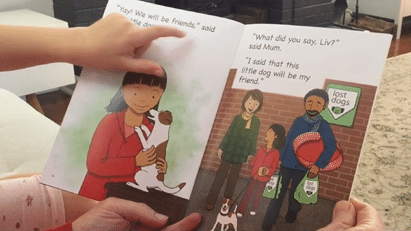For young readers, one of the most effective ways parents and carers can offer additional support at home is by spending as little as 10 minutes each day on supported book reading. In addition to sharing a wide range of books, in which you explore together the joy of reading – delving into imaginary worlds, exploring playful language, and investigating special topics of interest – we recommend also including sequential, decodable readers. These are books designed specifically to offer plenty of opportunity for children just starting to read to develop decoding skills.

InitiaLit Readers
InitiaLit Readers take a structured, systematic approach and help children build their knowledge of letter-sound correspondences so they can decode unfamiliar words. The books step you through the process of practising sounds, reading tricky words, learning new vocabulary and developing comprehension, while you enjoy a delightful story or non-fiction text.
Steps for effective reading and understanding
- Begin at the ‘Ready and Set’ pages in the front of the reader
- Ask your child to read the single sounds listed
- Ask them to practise reading some words with the target sound
- Practise reading the ‘tricky’ words that appear in that story – these are the words that cannot be easily sounded out and that your child will need to start to recognise.
- Look at the front cover together. Read the title and then the description on the back cover to your child. Ask them questions to engage their interest and talk about what the story might be about.
- If there are any vocabulary words listed, you can discuss their meaning and where they might have encountered this word before.
- Now you are ready to start reading the story. As your child reads, encourage them to use their finger to follow along the text.
- Leave your child time to sound out words and self-correct rather than jumping in quickly to correct them, which may chip away at confidence. If they are having trouble with a word, offer specific feedback and encouragement such as, “Sound out through the word.” If this is unsuccessful, you can demonstrate for them, and then do it together. If your child struggles to recognise a tricky word, you can provide the word for them.
- Be specific when offering praise. Decoding is about learning letter-sound correspondences, so provide positive reinforcement focused on this – for example, “That’s right, that’s the /g/ sound we have been learning about.”
- Make the reading experience rewarding through frequent praise, when your child sounds out a difficult word, self-corrects, or when they use good expression.
- If you are using a shared reader, you are alternating reading with your child to model fluent reading. You read the pages with smaller text, that are marked with a coloured triangle in the corner, and your child reads the opposite page.
- When you finish the reader, use the ‘Check for Understanding’ page at the back of the book to ask several questions and talk about the story together. This is an important step to improve reading comprehension.
- Don’t be afraid to come back to the same readers again, so that your child can read it several times, developing fluency and expression. You can also read the extra laps words at the back of the book to practice target sounds and get a quick decoding boost at any time.
Beyond decodable books
Beyond around Year 1 at school, as students ‘graduate’ from decodable books and move on to natural language texts, we recommend they continue to read aloud each day to a supportive adult. As they advance, parents can move beyond purely factual questions to ask more inferential questions about what has been read.
Equally, even once a child can read independently, there is great benefit in continuing to read to them regularly, choosing more complex texts than they would be able to read on their own. This is essential to build language comprehension, and ideally will be maintained all the way through primary school.
More information
InitiaLit Readers are available for anyone to purchase via the MultiLit website.
Our entire InitiaLit Reader collection is also now available via the MultiLit eLibrary for school subscriptions, and may be available through your school.